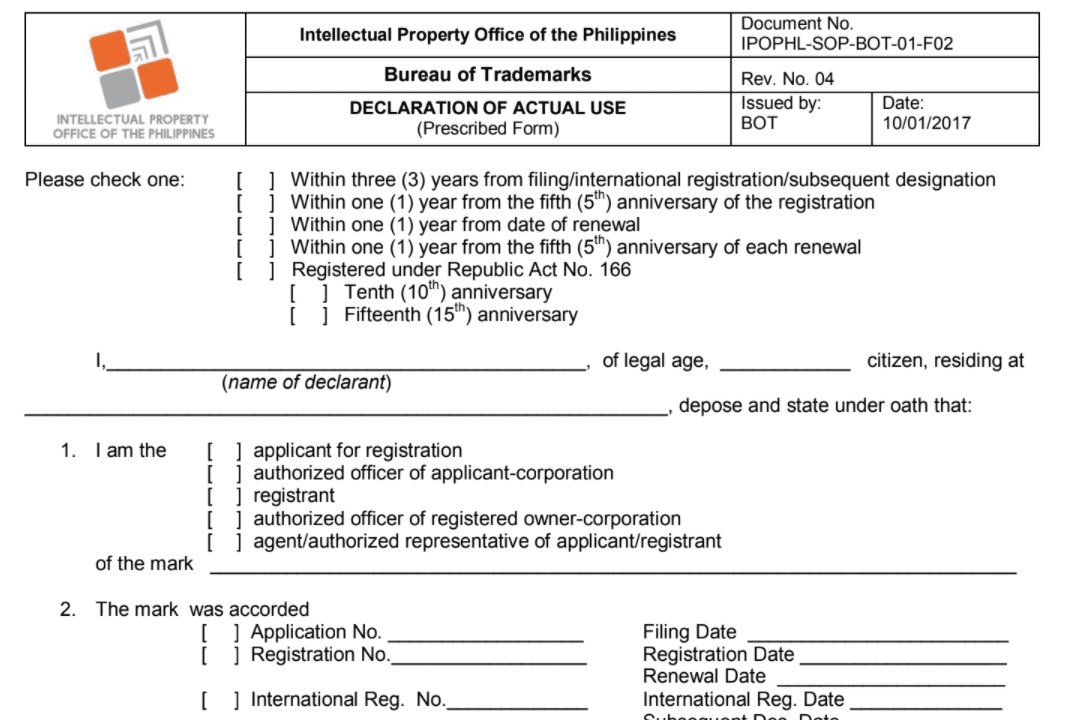How to Maintain Your Trademark (Declaration of Actual Use)
Maintaining your rights to your trademark takes effort.

Maintaining your trademark is easy if you file the requirements on time.
Registration grants you initial rights to your trademark.
However, you need to show continuous use to maintain of the mark to keep your rights to it. This is done by filing a Declaration of Actual Use (DAU) with the IPO PHIL office on a set schedule.
Below, I’ve outlined the steps on how to maintain your trademark and include everything you need to understand the process.
Why do I Need to Maintain my Trademark?

The government will revoke your trademark if it is not being used.
The IPO PHIL office removes your rights to your trademark from its system if proof of actual use is not filed.
After all, why give an owner rights to a mark if it is not being used?
Since your mark must be used for you to maintain rights over it, you will need to file proof of use.
These are photos of the mark used on labels, marketing materials, the company website, etc. along with a form called the Declaration of Actual Use or DAU.
What does a Declaration of Actual Use look like?
A Declaration of Actual Use looks like this.

It is important to fill the DAU form correctly to avoid serious problems.
You will need the following information:
1. Period being filed for.
2. Name, citizenship and address of person filing
3. Registration/application/international registration date and number
4. NICE classes
5. Outlets where the product is being sold
6. Proof of Use
Proof of use is fairly straightforward – it’s how you use the trademark in your business.

Actual Use is basically the use of your trademark in your day to day business.
So, this would be pictures of marketing materials, printed pages of your website, labels and contracts where your mark was used.
For online stores, it would be a receipt that proves that the transaction took place in the Philippines. Then, notarize your application.
Remember also to include all the classes the trademark is being used for when you file the DAU. If a class is not included in the DAU, then it is dropped from the registration or application. [Rule 209 of the Implementing Rules and Regulations, July 2017]
What is a Declaration of Non-Use (DNU)?
Sometimes, it might not be possible to file a Declaration of Actual Use.
If you fall under one of the below cases, you can instead file a Declaration of Non-Use.

DNU is an option only in specific situations.
The IPOPHIL recognizes the below situations for filing a DNU:
1. The registered owner is prevented from using it as a requirement imposed by another government agency
2. An existing restraining order or injunction issued by a court, the IPO or other quasi-judicial bodies prevents the use or,
3. The mark is the subject of an opposition or cancellation case.
Filing the DNU in lieu of the DAU helps you maintain your rights to the mark.
But note – it’s still subject to the same deadlines, so keep an eye on your calendar!
When should the DAU/DNU be filed?

Be punctual so you don’t miss the deadline
The DAU has to be filed on time.
With the exception of the 3rd year DAU and late fees, there are no extensions available.
This means that if you miss the DAU deadline, your trademark registration will be removed from the registrar.
The deadlines are:
1. Within 3 years from the application date
2. Within 1 year from the 5th anniversary of registration
3. Within 1 year from the renewal date
4. Within 1 year from the 5th anniversary of renewal
The first DAU (3 year DAU) is a bit different from the rest of the DAUs.
• It is counted 3 years from the application date
• It has a one time extension of 6 months, upon the payment of fees. This extension must
also be filed within the 3 year period.

You must be strict with time when filing a DAU.
To clarify, I’ve put together a timeline:
As you can see, everything else is counted from the date of registration.
And everything else has no extension available – so if you miss it, you miss it.
Keep your calendar handy and marked with the trademark schedule – it’s really important to monitor and keep track of these deadlines.
What is the Trademark Application Date vs the Registration Date?
DAU deadlines depend on 2 dates:
• The application date
• The registration date
All DAUs except for the 3rd year DAU are based off of the registration date.
The 3rd year DAU however is based off of the application date.

Don’t confuse the deadlines!
The application date is the date that a complete application was paid for.
However, what happens when you paid for an incomplete application? An incomplete application might be missing contact information or the list of good that the mark covers.
In this case, IPO PHIL will notify you of the missing information. IPO PHIL gives you 2 months to reply from the mailing date to complete the data. The Office will then give you a new application date, which is the date they received your completed information.
(This is subject also to priority rights, so it can get confusing.)
The registration date is the date when the mark was officially registered and is noted in the Certificate of Registration (COR).
How much does it cost to file a DAU/DNU?
Filing a DAU is subject to the below fees.
As always, remember that fees are per class.
The more classes filed, the more the DAU costs.

DAU has different filing fees according to the size of the entity and it’s class.
Summing it Up
Corporations and applicants focus on the initial trademark filing.
But the DAU is a crucial part to maintaining your rights to the application.
In the Supreme Court Case G.R. 194307, the Supreme Court noted that the inability to file the DAU on the 10 year anniversary was “tantamount to the abandonment or withdrawal of any right or interest the registrant has over his trademark.”

Knowing what to do and how to do things beforehand can save you from trouble in the future.
The rights to the trademark were given to anther person who filed due to the lack of the DAU 10th year anniversary filing.
So, keep a strict eye on your calendar! The DAU is just as important as the application in maintaining your rights to your trademark.






0 Comments